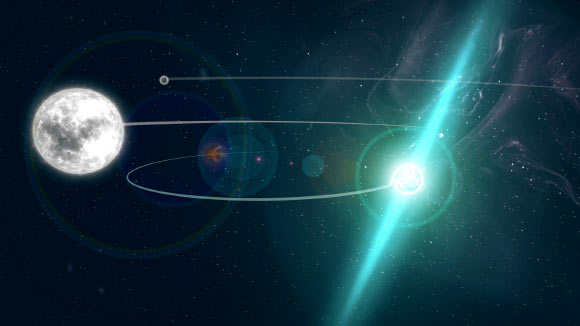In a new test of Einstein’s theory of gravity, a group of astronomers from the Netherlands, the United States, Australia and Canada has demonstrated that the theory holds up, even for a stellar triple system. Their work is published in the journal Nature.

An artist’s impression of the triple star system PSR J0337+1715, which is located about 4,200 light-years from Earth. Image credit: NRAO / AUI / NSF / S. Dagnello.
Einstein’s theory of gravity states that all objects fall the same way despite their mass or composition, like a cannonball and apple falling off the Leaning Tower of Pisa and hitting the ground at the same time.
To date, Einstein’s equations have passed all tests, from careful lab studies to observations of planets in our Solar System.
But alternatives to his theory predict that compact objects with extremely strong gravity, like neutron stars, fall a little differently than objects of lesser mass. That difference would be due to a compact object’s so-called gravitational binding energy — the gravitational energy that holds it together.
In 2011, astronomers discovered a natural laboratory to test Einstein’s theory in extreme conditions — PSR J0337+1715, a hierarchical system of three stars in which a binary consisting of a millisecond radio pulsar and a white dwarf in a 1.6-day orbit is itself in a 327-day orbit with another white dwarf.
“PSR J0337+1715 is a unique star system. We don’t know of any others quite like it. That makes it a one-of-a-kind laboratory for putting Einstein’s theories to the test,” said team member Dr. Ryan Lynch, an astronomer at the Green Bank Observatory in West Virginia.
White dwarfs are very dense stars; while their size is comparable to the Earth, their mass is similar to that of our Sun.
Neutron stars are even smaller and denser than white dwarfs. They are made from collapsed cores of stars that have undergone supernova explosions and are the densest stars in the Universe.
Many spinning neutron stars are pulsars, sending regular lighthouse-like electromagnetic signals out through space that can be captured by radio telescopes here on Earth.
“We can account for every single pulse of the neutron star in PSR J0337+1715 since we began our observations,” said team leader Dr. Anne Archibald, from the University of Amsterdam and the Netherlands Institute for Radio Astronomy.
“We can tell its location to within a few hundred meters. That is a really precise track of where the neutron star has been and where it is going.”
If alternatives to Einstein’s picture of gravity were correct, then the neutron star and the inner white dwarf in PSR J0337+1715 would each fall differently toward the outer white dwarf.
“The inner white dwarf is not as massive or compact as the neutron star, and thus has less gravitational binding energy,” said team member Dr. Scott Ransom, an astronomer with the National Radio Astronomy Observatory.
Through careful observations and calculations, the researchers were able to test the system’s gravity using the pulses of the neutron star alone.
They found that any acceleration difference between the neutron star and inner white dwarf is too small to detect.
“If there is a difference, it is no more than three parts in a million,” said team member Dr. Nina Gusinskaia, from the University of Amsterdam.
“Now, anyone with an alternative theory of gravity has an even narrower range of possibilities that their theory has to fit into, in order to match what we have seen.”
“Every single time we’ve tested Einstein’s theory of relativity so far, the results have been consistent,” said team member Professor Ingrid Stairs, from the University of British Columbia.
“But we keep looking for departures from relativity because that might help us understand how to describe gravity and quantum mechanics with the same mathematical language.”
The team’s result is 10 times more precise that the previous best test of gravity, making the evidence for Einstein’s Strong Equivalence Principle that much stronger.
“We’re always looking for better measurements in new places, so our quest to learn about new frontiers in our Universe is going to continue,” Dr. Ransom said.
_____
Anne M. Archibald et al. 2018. Universality of free fall from the orbital motion of a pulsar in a stellar triple system. Nature 559: 73-76; doi: 10.1038/s41586-018-0265-1







